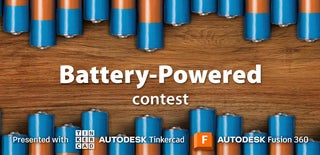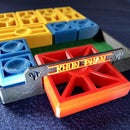Introduction: Mini Fan "Light Breeze" - Battery Powered - 3D Printed
A mini fan ... just right for the coming season! A fan, battery operated, small and handy. It will not create a hurricane but still a slight cooling breeze.
You can use it handheld or with stand.
Dimensions: fan Ø 110 mm, h 210 mm
Supplies
This mini fan can be powered by either one or two AA batteries. It doesn't matter for the motor, except that with 2 AA batteries (2 x 1.5V) he will run a little faster and more persistent.
Depending on what you choose, you will need to install an appropriate battery holder.
For this project you will need:
- the printed parts
- mini motor 3V (16500 RPM) https://www.amazon.de/dp/B082DZGV1R?psc=1&ref=ppx_yo2ov_dt_b_product_details
- battery AA
- battery holder (for one, respectively two batteries. For the two batteries you need a corresponding battery connector (see 2nd picture).
- 2 position mini toggle switch
- switching wire, about 10 cm. Normally there is a red and a black cable on the battery holder, respectively on the connector, long enough, so that you don't need any additional cables.
- 5 small Phillips screws Ø 2 x 5 mm
- soldering iron
- solder
- wrench 8 mm
- drilling machine
- Ø 2 mm drill bit
- a third hand can help
Step 1: Printing
Before you can start, you have to print the following parts:
- body.stl
- fan.stl
- front grid.stl
- lid.stl
- stand.stl (can be printed later, as it is not important for the assembly)
Print Settings:
- Printer brands: Prusa
- Printer: i3 MK3S, Prusa Mini
- Supports: No
- Resolution: 0,2
- Infill: propeller 40%, all other parts 10%
- Filament brand: Prusa, ICE
- Filament color: Galaxy Black; Wintershine White
- Filament material: PLA
Remark: As all parts are designed to fit very precisely, it may happen that you have to rework one or the other part a bit with sandpaper and/or cutter due to different dimensional accuracy of the printers and the different behavior of the filaments.
Step 2: Attach Battery Holder - 1 AA Battery
For this step need:
- "body.stl"
- battery holder (1 AA)
- 2 small Phillips screws Ø 2 x 5 mm (they should not be longer in any case, otherwise they will stand out on the front side!)
- Phillips screwdriver
- drilling machine
- Ø 2 mm drill bit
Since an attachment over the hole provided in the holder would lead to the fact that the then centrally seated screw head prevents a correct insertion of the battery, I drilled first two holes on the inside of the holder (Ø 2mm drill.)
The orientation of the cables does not really matter. However, I would align the side with the spiral down.
Note: After some experience with this device, I would recommend installing the holder for 2 AA batteries. It definitely makes more "wind".
Step 3: Attach Battery Holder - 2 AA Batteries
If you decide for this variant, you need:
- "body.stl"
- battery holder (2 AA)
- Velcro tape
- scissors
The 2 AA battery holder does not offer the possibility to fix it with screws. This would also not be a good solution, because every now and then the batteries need to be replaced. Therefore, a solution is needed that allows both. Velcro tape is the best solution for this.
Cut 1 piece each of 2-3 cm length from the hook and loop tape. Which piece you stick where is up to you. Note that you align the battery so that the connecting cable point upwards. Stick the counterpart into the fan as shown in the picture.
Step 4: Wiring and Soldering
Next you need:
- "body.stl" with mounted battery holder
- mini motor 3V
- switching wire, about 10 cm. Normally there is a red and a black cable on the battery holder, respectively on the connector, long enough, so that you don't need any additional cables.
- 2 position mini toggle switch
- soldering iron
- solder
- third hand
- wrench 8 mm
- 2 matches
The wiring is identical for both battery holder variants.
Put a battery in the holder and test which color assignment produces a clockwise running of the motor. This is necessary for the propeller to suck in air and move it forward. Normally, the motor will run clockwise if the red cable, coming from the positive pole of the battery, is connected to the left pin of the motor (see 1st picture).
Now go on with the black cable. Solder the black cable coming from the holder to one of the two poles of the switch. Solder a cable (10 cm) from the right pin of the motor to the other pole of the switch.
Now. that the wiring is done, the motor and switch can be installed.
Since the motor in my case is not quite tight in its box, it should be fixed. I took matches for this and snipped off two pieces of about 1 cm and pressed them into the upper corners. This way the motor sits firmly.
The position of the motor must be constantly checked later, during propeller installation, as the pressure on the motor shaft cannot prevent it from being pushed out.
Step 5: Installation Propeller
For this last step you need:
- the completed body
- "fan.stl"
The installation of the propeller seems uncomplicated at first glance. I found it to be not quite so simple. It is important to maintain the possibility of correction during the installation phase, because the clearance between the rear and front protective grids is not too large. The optimum is when no adhesive has to be used!
The hole in the propeller Ø 2 mm corresponds to the diameter of the motor shaft, also Ø 2 mm. Depending on filament and printer etc. the hole size of the propeller can be slightly different. You have to try this out. In one case the propeller sits tight, in the other case too loose. To prevent the propeller from slipping in any case, apply some superglue to the motor shaft and wait until it is dry. Then align the propeller so that it does not touch the rear grid.
You can test whether it turns without touching it by blowing on the propeller. It will then turn in the wrong direction, but in this case it does not matter. The distance between the rear grid and the propeller should be not more then 2 mm!
Also check from the side and from above if it is parallel to the rear side!
The clearance should be kept as small as possible, but note at higher speeds an unbalance can have a greater effect. Therefore, always make a test with battery!
After installing the propeller, check the seat of the motor and fix it again if necessary.
Step 6: Installation Front Grid
You need:
- the assembled body
- "front grid.stl"
- 3 Phillips screws
- Philips screw driver
The front protection grid has a tab with holes at the top and bottom. The tab with the 2 holes belongs to the top. The tab with the one hole disappears in the slot in the middle of "body.stl".
First fix the upper tab with 2 screws (Ø 2 x 5 mm). Inserting the screw inside is a bit difficult, because the screwdriver cannot be held vertically.
Even if the screwing is difficult at this point ... it must not be glued in any case, because then a correction of the propeller alignment is no more possible. The front grid must therefore remain removable!
It is also sufficient to fix it with a wire. The hole in the small base is open to the bottom!
Step 7: Inserting Cover
For this step you need:
- the assembled body
- "lid.stl"
- 1 Phillips screw
- Philips screw driver
Place the cover on the rear side and push it upwards. Then fasten it with a screw (Ø 2 x 5 mm).
Step 8: Stand
And last but not least you need:
- mini fan
- "stand.stl"
If you don't want to hold the small fan in your hand all the time, you can place it in a stand in the meantime.
Have fun with the Mini Fan and always a light cool breeze!
Step 9: Color Suggestions

Runner Up in the
Battery-Powered Contest


















